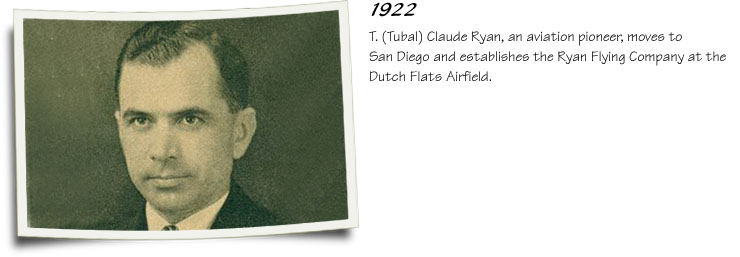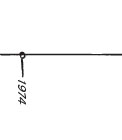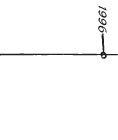

Historical Overview
T. Claude Ryan established the Ryan Flying Company in the early years of the twentieth century in San Diego. The Ryan Flying Company changed its name to Ryan Airlines, Inc. when it was reorganized in 1924 to begin operating the first year-round, scheduled airline service in the United States from Dutch Flats Airfield (URS Corporation, 2009). Around the same time, in the mid-1920s, Ryan entered the aircraft manufacturing business with partner Frank Mahoney and created the Ryan M-1 Monoplane, which became one of the best-known air mail carriers in the country. A modified Ryan Monoplane became the Spirit of St. Louis, the plane Charles Lindbergh flew from New York to Paris in May 1927 on the first solo flight across the Atlantic Ocean. Ryan sold the company to Mahoney in 1926 and established the Ryan Aeronautical Corporation for the sale and manufacture of aircraft engines. The company changed its name to the Ryan Aeronautical Company in 1934.
Ryan Aeronautical Company signed a 50-year lease, starting in 1939, on land at the southeastern edge of Lindbergh Field along North Harbor Drive. Three buildings from the site of the previous company were relocated to this new location. The Ryan plant was one of several aircraft manufacturers located at Lindbergh Field that contributed to the nation’s war effort in the 1940s. At peak wartime production, the Ryan plant had 8,500 employees and annual production exceeded $55 million. Following the war, workforce was reduced to 1,200 and annual production to $8 million (URS Corporation, 2009).
During the Korean conflict, Ryan Aeronautical played an important role by providing aircraft navigation and positioning equipment, including helicopter hovering devices, altimeters, and remote sensors (URS Corporation, 2009).
The company continued its longstanding relationship with the United States military when, in 1947, it was awarded a contract by the Navy to research the feasibility of reaction controls for jet aircraft. With jet engines and reaction controls handled by remote control, a Ryan vertical test rig lifted itself off the ground for the first time in 1950. In 1953, the Air Force awarded Ryan a contract to design and build two manned vertical takeoff jet research planes, and, two years later, the Ryan X-13 Vertijet was constructed. In the 1960s, Ryan continued target drone and electronic systems production and vertical takeoff and landing research (URS Corporation, 2009).
In 1969, the company was sold for $128 million to Teledyne Inc. and became known as Teledyne-Ryan Aeronautical Company (TDY Industries). T. Claude Ryan remained with the company as chairman until his death in 1982. In 1996, TDY Industries merged with Allegheny Ludlum Corporation, and then later became a subsidiary of that company. In 1999, Northrop Grumman Corporation acquired TDY Industries from Allegheny and relocated the plant to a site in Rancho Bernardo, California, leaving the former plant site vacant. The site continues to be mostly vacant, with only a small portion of Building 100 used for administrative offices and several other buildings used for storage.
T. Claude Ryan
T. Claude Ryan was born in Parsons, Kansas in 1898 but moved with his family to Orange, California in 1912. Ryan began a lifelong relationship with the aviation industry when, around the age of 19, he enrolled at the American School of Aviation in Los Angeles. In 1919 Ryan began studying mechanical engineering at Oregon State College. While in school, he applied to the Army for aviation cadet training and was accepted, but left the Army by January 1922 in hopes of flying as a civilian (National Aviation Hall of Fame, 2009). Ryan moved to San Diego, where he began giving airplane rides and flying instructions. He soon established the Ryan Flying Company at the Dutch Flats Airfield in San Diego, which later became Ryan Airport.
Ryan soon expanded his aeronautical enterprises to include flying school, flying service, and an airport manufacturing company. He was also instrumental in the development of the aviation industry in San Diego. In 1928, he helped to establish Lindbergh Field, San Diego’s nascent municipal airport. In 1939, Ryan established a manufacturing site on airport grounds, which became the headquarters for Ryan Aeronautical Company.
Ryan continued to operate the company until 1969, when it was sold for $128 million to Teledyne Inc. and became known as Teledyne-Ryan Aeronautical Company (TDY Industries). T. Claude Ryan remained with the company as chairman until his death in 1982.







